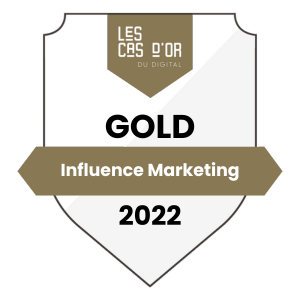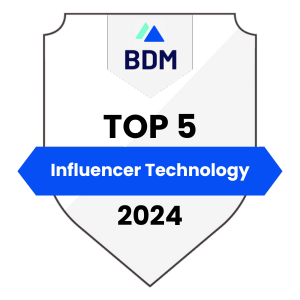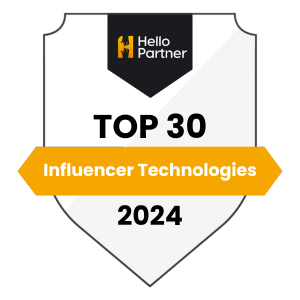#A
Unique codes provided to influencers that allow them to track sales or leads generated through their content. Influencers often share these codes with their followers, and in return, they earn a commission on each sale made using the code.
A set of rules and calculations used by social media platforms to determine which content is displayed to users in their feeds. Understanding algorithms is crucial for content creators to maximize the visibility of their posts.
A strategy where influencer campaigns run continuously, rather than in isolated bursts. This approach keeps the brand consistently in front of the target audience, maintaining engagement and brand awareness.
The group of followers who regularly engage with a content creator’s content on social media. Audience demographics, interests, and behavior are crucial for targeted influencer marketing.
The perception that a content creator’s content is sincere and trustworthy. Authenticity is critical for maintaining a strong relationship with the audience and ensuring the success of influencer marketing sponsored campaigns.
#B
Loyal customers, employees, or influencers who voluntarily promote and support a brand. Brand advocates are powerful in building trust and credibility through organic, word-of-mouth marketing, and they often champion the brand because of their positive experiences with its products or services.
The process of ensuring that a brand’s values, message, and image are in harmony with those of the influencer. Strong brand alignment is crucial for creating authentic and effective influencer partnerships.
A long-term partnership between a brand and an influencer, where the influencer consistently represents and promotes the brand in exchange for compensation. Brand ambassadors often embody the brand’s values and identity.
The increase in positive perception and awareness of a brand following an influencer marketing campaign. Brand lift is measured through surveys, sentiment analysis, and changes in brand-related metrics.
The measures taken by brands to ensure that their advertisements and content do not appear in contexts that could harm their reputation. In influencer marketing, brand safety involves selecting influencers who align with the brand’s values and avoiding controversial content.
#C
A document provided by a brand to an influencer outlining the objectives, key messages, deliverables, and guidelines for a campaign. A clear and comprehensive brief is essential for aligning expectations and ensuring successful outcomes.
Public figures or celebrities who leverage their fame and large following to endorse brands, products, or services on social media or other platforms. They typically are also Mega influencers.
A collaborative process where a brand and an influencer work together to create content that aligns with both the brand’s goals and the influencer’s style. Co-creation can lead to more authentic and engaging content.
A marketing strategy where multiple influencers or brands work together on a single campaign, sharing resources and audiences. Collaborative campaigns can amplify the message and reach a broader or more diverse audience.
The process of boosting the reach and impact of content created by influencers, typically through paid media, cross-promotion, or social media advertising. Content amplification ensures the content reaches a broader audience.
A strategic plan that outlines the schedule and themes for content creation and publication. In influencer marketing, content calendars help coordinate the timing and consistency of posts across multiple influencers.
An individual who produces and shares content on social media platforms, often with the capability to influence the opinions, behaviors, and purchasing decisions of their audience. Content creators include bloggers, vloggers, streamers and social media influencers.
The practice of granting a brand the rights to use content created by an influencer beyond the initial campaign, such as in advertisements, on websites, or in other marketing materials. Licensing agreements specify how the content can be used and for how long.
The distribution of influencer-created content across various platforms and channels to increase its reach. Content syndication can involve sharing posts on different social media sites, blogs, or even traditional media.
The process by which a targeted audience takes a desired action, such as making a purchase, subscribing to a service, or signing up for a newsletter, as a direct result of an influencer’s content.
An influencer marketing campaign that spans multiple social media platforms, allowing brands to reach diverse audiences and maximize exposure. Cross-platform campaigns require careful coordination to ensure consistent messaging across different channels.
A strategy where two or more content creators or brands collaborate to promote each other’s products or services to their respective audiences. Cross-promotion can increase reach and diversify audience exposure.
A directive given by the influencer to encourage their audience to take a specific action, such as clicking a link, subscribing to a newsletter, or purchasing a product.
#E
A metric that estimates the value of exposure gained through non-paid channels, such as social media shares, mentions, etc. Essentially, it quantifies how much the brand would have had to spend to achieve the same level of exposure through paid advertising. EMV is calculated by assigning a monetary value to each type of actions (likes, shares, comments, views, etc) and then summing these values to represent the total worth of the organic, earned exposure.
The level of interaction between a content creator and their audience, including likes, comments, shares, retweets, and views. High engagement often indicates a strong connection between the influencer and their followers.
A crucial metric that measures the level of interaction a piece of content receives relative to the size of the audience. It is often calculated as the sum of likes, comments, and shares divided by the total number of followers or reach. It shows how well the content resonates with the audience.
An agreement where an influencer commits to working with only one brand within a specific category, often in exchange for higher compensation. Exclusive partnerships enhance brand loyalty and prevent conflicts of interest.
#G
A promotional strategy where influencers offer their followers the chance to win a prize, often in exchange for engagement such as following, liking, or sharing content. Giveaways are used often to boost engagement and increase followers.
#H
A marketing strategy that encourages users to share content using a specific hashtag. Hashtag campaigns can generate widespread participation and engagement, making it easier to track the campaign’s reach and impact.
#I
A performance-based marketing strategy where influencers earn a commission for driving sales or traffic to a brand through special affiliate links or codes shared with their audience.
The data and metrics used to measure the performance of an influencer marketing campaign. Influencer analytics often include average engagement rates, reach, impressions, conversions, and sentiment analysis, helping brands assess the effectiveness of their partnerships.
A credential awarded to influencers who complete a specialized training program or course in influencer marketing. These certificates often indicate that the influencer has acquired knowledge and skills in areas such as content creation, audience engagement, ethical practices, and understanding of marketing strategies. Brands may view an influencer certificate as a sign of professionalism and commitment to the industry, potentially making the influencer a more attractive partner for collaborations.
The various forms of payment or rewards given to influencers in exchange for their promotional efforts. Compensation can include monetary payments, free products, affiliate commissions, or experiences.
The ongoing process of tracking and reviewing the content produced by influencers during a campaign. This includes assessing the content’s alignment with brand guidelines, checking for compliance with legal requirements (such as proper disclosure of sponsored posts), and evaluating the content’s engagement and reception by the audience. Content monitoring helps ensure that the influencer’s work meets the brand’s standards and objectives.
A legal agreement between a brand and an influencer that outlines the terms of their collaboration. This contract typically includes deliverables, payment terms, usage rights, confidentiality clauses, and expectations for both parties.
The process of finding and evaluating potential influencers who align with a brand’s objectives. Influencer discovery can be done through social media research, influencer marketplaces, or using specialized tools and platforms.
A phenomenon where audiences become desensitized to influencer promotions due to overexposure or perceived lack of authenticity, leading to diminished engagement and effectiveness of influencer marketing campaigns.
The process of identifying fraudulent activities in influencer marketing, such as fake followers, bots, or manipulated engagement metrics. Fraud detection tools and techniques help brands avoid wasting resources on ineffective partnerships.
The process of overseeing influencer relationships, campaigns, and contracts to ensure that brand partnerships run smoothly and deliver the desired results. Influencer management can be handled in-house or through an agency.
A type of marketing that involves collaborating with content creators including influencers to promote a company’s products, services or values to their followers. This strategy leverages the influencer’s credibility, reach and ability to engage to drive various objectives such as brand awareness and conversions.
A specialized firm that helps brands connect with influencers, develop strategies, and manage influencer marketing campaigns. Agencies provide expertise and resources to maximize campaign effectiveness.
A tool that connects brands with influencers. These platforms often provide analytics, campaign management tools, and databases of influencers to help brands and agencies execute their influencer marketing strategies effectively.
The process of contacting and building relationships with influencers to collaborate on marketing campaigns. Outreach often involves personalized communication to align the brand’s goals with the influencer’s content.
A predictive analysis that estimates the potential outcomes of an influencer marketing campaign before it is executed. This forecast is based on historical data, current trends, the influencer’s past performance, audience behavior, and other relevant metrics. Brands use performance forecasts to set realistic expectations, optimize their strategies, and allocate resources more effectively.
A comprehensive document that summarizes the results of an influencer marketing campaign. This report typically includes key performance indicators (KPIs) such as reach, engagement, conversions, ROI, and any qualitative feedback. An influencer report provides insights into what worked well, what could be improved, and the overall effectiveness of the campaign, helping brands make informed decisions for future initiatives.
A strategy where an influencer temporarily controls a brand’s social media account, posting content and engaging with the audience on behalf of the brand. Takeovers can drive engagement and offer fresh perspectives.
The process of categorizing influencers based on their follower count, engagement rate, and influence. Common tiers include nano, micro, macro, and mega-influencers, each with different strengths and strategic uses.
The process of evaluating potential influencers to ensure they align with the brand’s values, target audience, and campaign goals. Vetting includes assessing the influencer’s authenticity, engagement, and past content.
A practice where influencers grant brands access to their social media accounts to run ads directly from the influencer’s profile. This allows brands to amplify the influencer’s content while retaining the authenticity of the post.
#K
The specific metrics used to evaluate the success of an influencer marketing campaign. Common KPIs include engagement rate, reach, conversions, and ROI.
#L
An ongoing collaboration between a brand and an influencer that spans several campaigns or a continuous period. Long-term partnerships help build stronger brand affinity and credibility with the influencer’s audience.
#M
A content creator with a larger following, typically over 100,000 followers. While they have a broader reach, their engagement rate may be lower compared to micro or middle-influencers due to the larger and more diverse audience.
A portfolio created by influencers that showcases their audience demographics, content examples, engagement metrics, past collaborations and rates. Media kits help brands assess the potential fit and impact of an influencer.
They typically reach a broad and diverse audience over 1M followers, and their endorsements carry significant influence due to their established reputation. They can be celebrity influencers or not.
A content creator with a following between 50,000 and 100,000. Middle-influencers have higher engagement rates compared to larger influencers.
A content creator with a following between 10,000 and 50,000. Micro-influencers are known for having a closer relationship with their audience, often resulting in higher engagement rates compared to larger influencers.
#N
A content creator with a small but highly engaged audience, typically under 10,000 followers. Nano-influencers are known for their strong personal connections with their audience and high authenticity.
A content creator who focuses on a specific subject area or industry, attracting a highly targeted audience with particular interests. Niche influencers often have deep expertise and strong influence within their domain.
#P
A marketing strategy where a brand’s products are strategically placed within content created by influencers, often seamlessly integrated into their videos, photos, or posts. Unlike overt advertisements, product placements are subtle and are designed to appear as a natural part of the content. These campaigns aim to promote products in an organic way that resonates with the influencer’s audience, enhancing brand visibility and credibility without interrupting the viewer’s experience.
Code to offer a discount or special promotion on products or services. Promo codes are used to track the effectiveness of an influencer’s campaign by measuring how many sales or conversions are directly attributed to the influencer’s promotion. These codes are a popular tool in affiliate marketing and help incentivize purchases among followers.
#R
The total number of unique individuals who have seen a content creator’s post. Reach is a key metric in determining the potential spread of a social media post.
A key metric used to evaluate the financial effectiveness of a campaign. It’s typically calculated by dividing the net profit from the campaign by the total cost of the campaign. However, ROI can also take into account the value generated from non-monetary gains, such as brand awareness and social engagement, which can be quantified through metrics like Earned Media Value (EMV). In this broader sense, ROI reflects both the direct revenue and the indirect value gained from the campaign.
#S
The practice of sending free products or samples to influencers in the hopes that they will feature or review the products in their content. Seeding helps generate organic buzz and can lead to earned media coverage.
The process of analyzing the emotions and opinions expressed in social media posts, comments, and reviews. Sentiment analysis helps brands understand public perception and the impact of influencer campaigns.
The influence that the actions and opinions of others have on individuals, which content creators leverage to encourage their followers to engage with a brand or product. Social proof is a powerful tool in influencer marketing.
Content created by a content creator in partnership with a brand, where the brand compensates the creator to promote its products or services. Sponsored content should align with the creator’s style to maintain authenticity.
The technique used by content creators to craft narratives that engage and captivate their audience, often making product placements or brand messages more relatable and immersive.
#U
Users or followers of a brand who create and share content related to that brand, often voluntarily. UGC creators provide authentic content that enhances brand credibility and engagement, as their content is perceived as more genuine by other consumers. There are now more and more professional UGC content creators who are hired by brands.
#V
Metrics that may look impressive but do not directly contribute to business objectives, such as total follower count or number of likes. In influencer marketing, it’s important to focus on metrics that drive meaningful results.
Digital characters or avatars created using CGI (computer-generated imagery) that function as influencers on social media. Virtual influencers are controlled by brands or creative teams and can engage with audiences just like human influencers, offering brands a high level of control over messaging and image.









